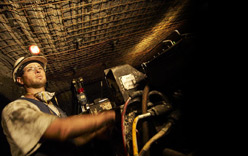Ventilation
Good quality air has to be provided for personnel to
breath, to dilute both natural and introduced (e.g. diesel exhaust) gases, to
dilute or carry away dust and to provide cooling for personnel and machinery. A
small quantity of air may flow through mine workings naturally but this would
be insufficient and uncontrolled and therefore it is necessary to provide a
mechanical means of ventilating the mine.
To do this at least two connections between seam and
surface are required and large fans are connected to one of these. These are
primarily exhaust fans which suck air into the mine from the surface via the
other connection(s), through the roadways to where mining operations are being
carried out and back to the surface through the exhausting fan(s). A few mines
do use intake or "forcing"
fans, particularly in the US where exhaust adits are mined to outcrops. The
roadways underground are divided into 2 groups, those carrying fresh air into
the workings ("intake airways") and those carrying used air back out ("return airways"). Adjoining intake and return airways are
separated by the coal pillars or by installing "stoppings" (most commonly in the form of a wall of some
kind) in any interconnecting roadways to prevent air short-circuiting between
the roadways. Sometime doors are used in place of stoppings to allow passage of
equipment or personnel where required. Where air routes have to cross, a
section of roof or floor is removed and an artificial tunnel constructed to
carry return air over (most commonly) or under the intake air. These structures
are known as "overcasts".
Where there is more than one location where mining is
being carried out, legislative requirements (and good mining practice) require
that no air used to ventilate one working location can be used to ventilate
another. This requires a number of separate circuits off the main roadways
known as ventilation "splits".
Other control devices are required to ensure adequate
flow to all parts of the mine (if not controlled, air will take the path of least
resistance back to the fans). Flow to different areas of the mine is regulated
by constructing artificial restrictions in airways in the form of a stopping or
doors with an opening usually of an adjustable size (by the use of adjustable
louvers, sliding doors, etc), such restrictions being known as "regulators".
All installations such as stoppings, overcasts, doors,
regulators, etc are known collectively as "ventilation control devices or
VCD's".
With all the above taken into account, what appears a
simple process can become very complex.
Because mine fans operate continuously and require
considerable power to do so, ventilation efficiency is an important
consideration and fan specification and ventilation circuit maintenance become
important cost considerations.
At the point where roadways are being driven in
advance of the ventilation circuit other measures are required to enable air to
travel into the advancing roadways. These measures include using a temporary
"wall" of flexible, air tight material (known as "brattice") to create a ventilation circuit in the
advancing roadways(s), or by using ventilation ducting combined with a
relatively small fan (an "auxiliary fan") to cause air to flow into the advancing roadway(s).
The state of the mine ventilation needs to be
monitored to ensure that the quantity of air is maintained consistently and
that emitted gas levels are maintained below safe threshold levels. Monitoring
is done both manually and by the use of continuously operating monitors that
may indicate remotely, often to the surface.

